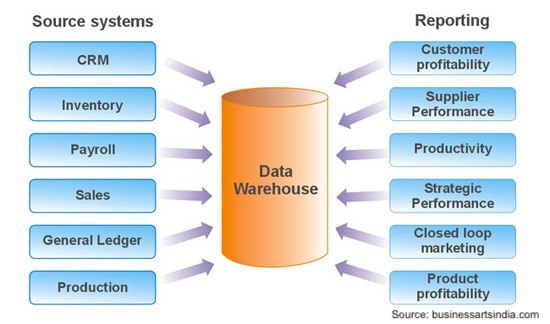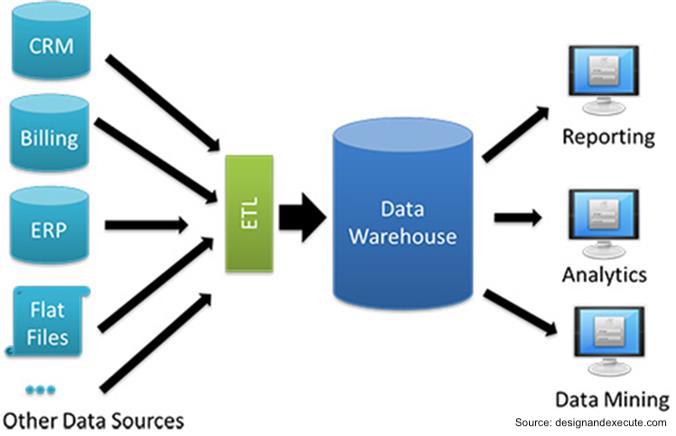The role of data is changing significantly with advanced methodologies used for upgrading sales and integrating business intelligence in the organizational schema for better outcomes.
But in the absence of proper tools and techniques to manage and organize such a large pool of data, results might appear too far-fetched. So, what is the way out to handle bundles of unstructured data and harness its true potential for catalyzing growth?
Data warehousing is the solution that enterprises seek to support in decision making and grabbing potential markets using real-time insights provided by it. Data analytics helps in reporting, analyzing, and creating numerous use cases that revolve around solving your business problems.
Today, several industries around the globe are partnering with data warehousing consultants or data warehousing companies to streamline their business processes.
Data warehouse is an advanced system designed to help enterprises perform data analysis and reporting. The organization has multiple sources to collect data; therefore, it requires an advanced approach that structures all collected data and harnesses the value from it to speeds up the decision-making process and contribute to the faster growth of the organization.
But modernizing the use of such a huge chunk of unstructured data requires an innovative approach. Therefore, enterprises trust DW-a-a-S for this purpose where data usage by integrating the organization’s operational system (ERP, Historian, PI System) can be simplified under one hood termed as data warehouse and refining process can work better to fit in the use cases that directly contributes to the growth and market capitalization.

A data warehouse is a repository of digital data stored by the enterprise. The primary purpose of data warehousing is to allow companies to access the huge amounts of data stored in the centralized database. The data is cleaned, formatted, and analyzed to provide actionable insights.
The right data warehouse is used as a data management system where business intelligence and data analytics can be performed to understand patterns in the data and derive actionable insights for decision-making purposes. The data warehouse is used to run queries to find the information the business wants and can seamlessly deal with large datasets, unlike database systems.
Data warehousing is not a new concept in the industry. With data becoming increasingly available from several sources, enterprises need to find a way to store this data and use it for analytics. A data warehouse is a comprehensive solution as it can store huge volumes of data in its multi-tier structure. It can be a physical storage unit located on-site or a cloud storage platform accessed through the internet.
Depending on the size of your business and the data collected, you can opt for either of the data warehouse architecture:
A data warehouse is important to run business intelligence tools without spending too much money on querying. It helps define the data flow within the enterprise and makes it easy to access and share data among the departments and teams.
Data warehouse works like a big data lake of information that is designed to store and preserve a large chunk of information. Business requires real-time insights that support trend analysis by setting up an efficient system that improvises the processing and sorting of details; thus preventing data duplication and creating a better usable data history that yields results.
Such an approach or working of data warehouse helps in maintaining a complete data history even if it has been purged from different source transaction systems.
When the data gets assembled from a data lake is one place working like dashboards, the resulting outcome is different business applications working efficiently to deliver quality as they have just one data source from where they can extract information and refine the data for different purposes in the organization.
Decisions are important in business and they can be perfect when fuelled by insights from real-time data collected. While framing the business strategy or setting up a specific operational module as a standard operating procedure (SOP), corporations have to rely on data-driven facts that can help them take concrete decisions.
Real-time insights from unstructured or parsed data that establish a better data visualization can increase the efficiency in market segmentation, inventory management, financial management and lastly sales.
In this way, the business can grow up to become much more competitive and market-ready to withstand any disruptions occurring at the technology, trends, or consumer behavior.

Data warehouse is not just a godown storing information rather a place that expedites the data retrieval process and organizes data engineering and analysis. When you need to make quicker decisions, the presence of a system that can query the stored data in a structured manner and provide real-time feedback simply makes the process swift.
The high-performance data analysis helps in understanding trends and adapting as per the change so that better decisions can be made in due time that delivers results for the corporations.
Data warehouses create one single dashboard that stores KPI or Key Performance Indicators. Some of the data indeed are KPIs that influence decision making and when they are available in a flash, it saves a lot of time for the corporation.
When one dynamic dashboard works in the organization, the higher management does not have to rely on the IT team for collecting data.
When you have access to one single dashboard that performs multiple functions, decision-making becomes faster as you do not have to spend much time on gathering data, rather, you can focus more on the analysis that can influence the outcomes.
Quality enhancement is necessary for creating a frugal data visualization that has the potential to influence decision-making with long-term objectives. In data warehousing, the collection of data happens from multiple sources that make them consistent and standardized.
As there is one single dashboard that controls all the data stored in the warehouse, different departments in the organization like sales, marketing and operations easily access the data and use it for meeting their designated objectives. The availability of key data at the right time supports faster decision-making and better results for the organization.
The core purpose of using data warehousing as a service (DW-a-a-S) by most corporations is to minimize the cost and push up the profits. But this stuff is not as simple as it may sound to you.
Data simplifies the process though with future speculations by identifying the habits of the consumers, market and suggesting future trends based on which the planning can work. Such key inputs influence decision-making with real-time analytics to support or stand against market disruptions.
With such an approach, ROIs are bound to fall into place that benefits the organizations at large.
Thus, you can see that DW-a-a-S has true potential and it has been changing the business landscape by providing real-time business insights that shape business models and speed up the decision-making process. Here is how we created a small Data Mart for one of the start-ups with a low budget. For more information regarding Data Warehousing as a service contact us.
